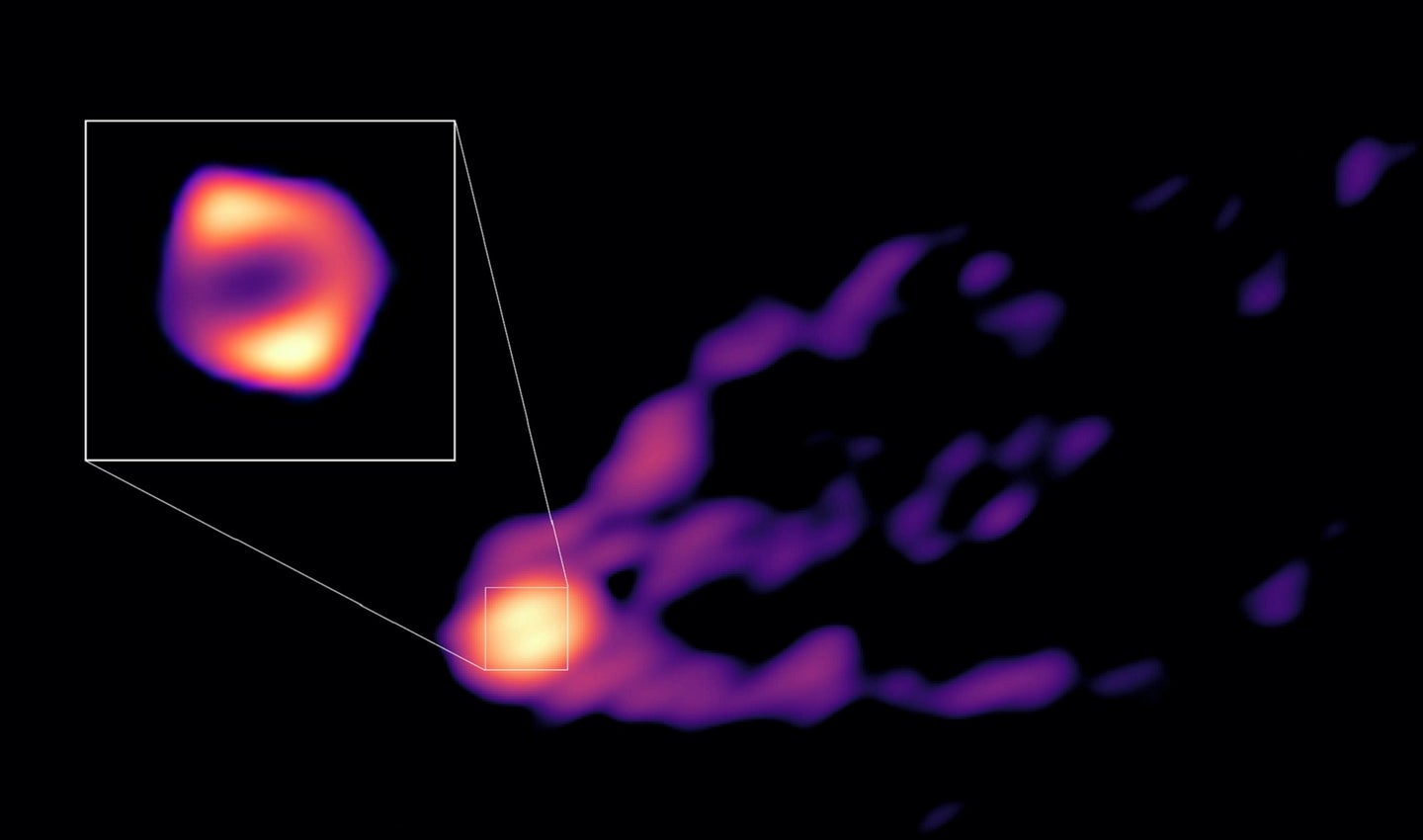This supermassive black hole sucks big time
We knew M87, the first black hole to be seen by humans, was powerful. But not this powerful.

Black holes remain among the most enigmatic objects in the universe, but the past few years have seen astronomers develop techniques to directly image these powerful vacuums. And they keep getting better at it.
The Event Horizon Telescope (EHT) collaboration, the international team that took the first picture of a black hole in 2017, followed up that work with observations highlighting the black hole’s magnetic field. And just this month, another team of astronomers created an AI-sharpened version of the same image.
Now a new study published today in the journal Nature describes how images of that black hole, named after its galaxy, Messier 87 (M87), has a much larger circle of debris around it than the 2017 observations would suggest.
Though long hypothesized to exist in theory, for many decades astronomers could only find indirect evidence of black holes in the sky. For instance, they would look for signs of the immense gravity of a black hole influencing other objects, such as when stars follow especially tight or fast orbits that imply the presence of another massive, but invisible partner.
But that all changed in 2017, when the EHT’s global network of radio telescopes captured the first visible evidence of a black hole, the supermassive black hole at the heart of a galaxy 57 million light-years away from Earth. When the image was released in 2019, the orange ring of fire around a central black void drew comparisons to “The Eye of Sauron” from Lord of the Rings.
EHT would go on to directly image Sagittarius A*, the supermassive black hole at the heart of the Milky Way galaxy, releasing another image of a fiery orange doughnut around a black center in May 2022.
Such supermassive black holes, which are often billions of times more massive than our sun—M87 is estimated to be 6.5 billion times bigger and Sagittarius A* 4 million times bigger—are thought to exist at the centers of most galaxies. The intense gravity of all that mass pulls on any gas, dust, and other excess material that comes too close, accelerating it to incredible speeds as it falls toward the lip of the black hole, known as the event horizon.
[Related: What would happen if you fell into a black hole?]
Like water circling a drain, the falling material spirals and is condensed into a flat ring known as an accretion disk. But unlike water around a drain, the incredible speed and pressures in the accretion disk heat the inflating material to the point where it emits powerful X-ray radiation. The disk propels jets of radiation and gas out and away from the black hole at nearly the speed of light.
The EHT team already figured that M87 produced forcible jets. But the second set of results show that the ring-like structure of collapsing material around the black hole is 50 percent larger than they originally estimated.
“This is the first image where we are able to pin down where the ring is, relative to the powerful jet escaping out of the central black hole,” Kazunori Akiyama, an MIT Haystack Observatory research scientist and EHT collaboration member, said in a statement. “Now we can start to address questions such as how particles are accelerated and heated, and many other mysteries around the black hole, more deeply.”
The new observations were made in 2018 using the Global Millimeter VLBI Array, a network of a dozen radio telescopes running east to west across Europe and the US. To get the resolution necessary for more accurate measurements, however, the researchers also included observatories in the North and South: the Greenland Telescope along with the Atacama Large Millimetre/submillimetre Array, which consists of 66 radio telescopes in the Chilean high desert.
“Having these two telescopes [as part of] the global array resulted in a boost in angular resolution by a factor of four in the north-south direction,” Lynn Matthews, an EHT collaboration member at the MIT Haystack Observatory, said in a media statement. “This greatly improves the level of detail we can see. And in this case, a consequence was a dramatic leap in our understanding of the physics operating near the black hole at the center of the M87 galaxy.”
[Related: Construction starts on the world’s biggest radio telescope]
The more recent study focused on radio waves around 3 millimeters long, as opposed to 1.3 millimeters like the original 2017 one. That may have brought the larger, more distant ring structure into focus in a way the 2017 observations could not.
“That longer wavelength is usually associated with lower energies of the emitting electrons,” says Harvard astrophysicist Avi Loeb, who was not involved with the new study. “It’s possible that you get brighter emission at longer wavelengths farther out from the black hole.”
Going forward, astronomers plan to observe the black hole at other wavelengths to highlight different parts and layers of its structure, and better understand how such cosmic behemoths form at the hearts of galaxies and contribute to galactic evolution.
Just how supermassive black holes generate jets is “not a well-understood process,” Loeb says. “This is the first time we have observations of what may be the base of the jet. It can be used by theoretical physicists to model how the M87 jet is being launched.”
He adds that he would like to see future observations capture the sequence of events in the accretion disk. That is, to essentially make a movie out of what’s happening at M87.
“There might be a hotspot that we can track that is moving either around or moving towards the jet,” Loeb says, which in turn, could explain how a beast like a black hole gets fed.